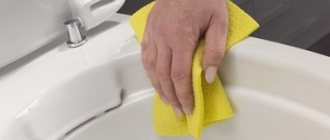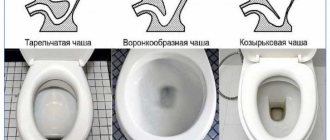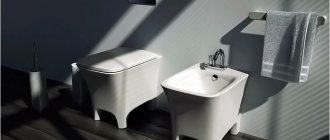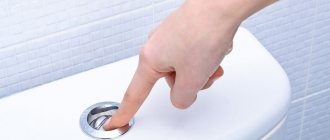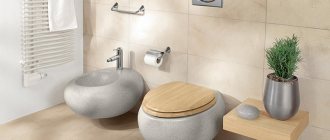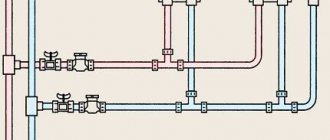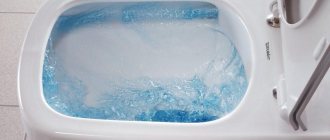- December 20, 2020
- Miscellaneous
- Alisa Krasnova
Ceramic toilets have thick walls and a heavy glaze. The latter acts as a barrier to prevent damage. Ceramic is a brittle material and can easily chip, crack or break when trying to drill into a surface. Drilling holes requires not only special tools, but also the steady hand of a plumber to avoid irreparable damage. Now you will learn how to drill a toilet carefully and safely.
Gluing the toilet
Scenario 1
For example, an eyelet for attaching a shelf or a piece of base?
- For gluing, use any universal glue from a reputable manufacturer. “Super Moment” from Henkel will do just fine.
- We clean the surface of the chip from dust and crumbs.
- Let the earthenware or porcelain dry completely.
- Degrease surfaces with acetone or gasoline. You can skip this step only if the chip is completely fresh: grease and soot from the kitchen will contaminate the surface in just a few days.
- Apply glue and press the broken fragment. We fix it in any way for the time specified in the instructions for the glue.
The simplest case.
Scenario 2
How to seal a toilet if a piece of earthenware is broken off where water collects?
This often happens when foreign objects fall into the bowl.
- Here it is better to use not universal adhesives, but two-component epoxy resin. Prepare the resin and hardener itself, as well as the container in which you will mix them.
- Dry the surfaces to be bonded completely. Turn off the water to the tank, install a fan, and wipe off all drops and splashes. The gluing area must be completely dry.
- Again, if at least a couple of days have passed since the toilet bowl was split, degrease the surfaces.
- Mix the resin and hardener according to the instructions. Apply the resulting glue to the surfaces to be glued.
- Fix the gluing area in any way. Regular tape placed on the outside of the bowl works perfectly.
- After the resin has dried, carefully sand the adhesive seams where they are visible: first with sandpaper - zero grade, then with felt. Otherwise, they will collect unappetizing-looking dirt.
Here the situation is more complicated. But epoxy resin will help.
Scenario 3
How to repair a crack in a toilet bowl if it is visible on both sides of the bowl? It is necessary to ensure tightness and prevent crack expansion.
We will need:
- Epoxy resin with hardener. In this case, it is the best glue for the toilet;
- Drill and thin drill bit for tiles;
- Grinder with a disc for stone;
- Sandpaper and felt for sanding the gluing area.
The main operations will be as follows:
- At the ends of the crack we drill two thin through holes. They will prevent the crack from extending.
- Using a turbine, we select a depression along the entire crack to about half the thickness of the earthenware. Be careful: overheating the earthenware will make the situation worse, causing it to crack in new places. Whether you do it from the inside or outside of the bowl makes no difference: the crack will be noticeable in any case.
- Fill the prepared recess with epoxy resin mixed with hardener. The holes are also filled; Remove excess resin immediately. This will save us some sanding work.
- We sand the hardened resin using the method described above.
In some cases, unfortunately, it is simply impossible to get to the problem area.
Scenario 4
Alas, no way. All attempts to drown the base in concrete will lead to only one thing: when the upset neighbors below come to you and begin to complain about the fungus, you will spend much more effort on dismantling the old toilet when replacing it.
If the base is cracked and water is flowing, you can go for a new toilet.
We start with cleaning. We carefully clean the damaged surface or chip with sandpaper, then wipe it, freeing it from small particles. After this, we degrease it with acetone or gasoline and warm it up thoroughly with a hairdryer to evaporate all the moisture from the area of the future seam. If the damage has a complex fault topography, the preparation will be somewhat different.
In this case, sanding may cause damage. If you use it to excessively cut off the bulges, voids may form during the gluing process, the presence of which will negatively affect the strength of the seam. Therefore, we process such a fracture only lightly, blow out small fragments with a hairdryer, degrease, dry and lubricate with a thin layer of glue.
We take the glue, carefully read the instructions and then act in accordance with the recommendations. Most often you will need to carefully apply a layer of adhesive and wait a while. Then we press the surfaces to be glued with force. The result will largely depend on the pressing force - the greater it is, the stronger the seam will be.
You must carefully read the instructions for the glue and be guided only by it during the work process.
The seam inside the toilet needs to be strengthened. We clean it again with sandpaper, degrease it and dry it well with a hairdryer. Then we coat the seam with glue, on which we lay a strip of thin plastic or soft metal, which will act as an amplifier. We treat glued external damage with a special grout designed for ceramic tile joints.
Work order
First of all, the split site must be cleared of dust and various small fragments. For this you will need:
- sandpaper;
- soft fabric;
- solvent.
The first step is to clean the place where the piece was broken off. The more complex the crack, the less it is necessary to clean the place, so as not to aggravate the situation. After light sanding, quickly wipe the cleaned area with a soft cloth.
After wiping, lubricate the clean surface with solvent or acetone to degrease the gluing area. After all these procedures, you need a regular or construction hair dryer, which can quickly dry the damaged area.
The split is lubricated with an adhesive waterproof solution or sealant, then the splinter is applied. In some cases, you can use a double layer of glue. It is necessary to apply as much force as possible to create good adhesion to the glue.
But if you overdo it, the chipped part or the chipping site will be destroyed even more, so it is important to calculate your effort
The fragment can be fixed with tape or a tight tourniquet. If everything is done correctly, the chipped part will be firmly glued and can last for quite a long time.
This method is suitable for gluing minor chips on the outer part of the toilet. If the split occurs inside the bowl, then it is better to use epoxy resin instead of the adhesive mixture. But some serious damage cannot be repaired using this method.
For the flush cistern, the procedure is absolutely the same as in the case of the toilet. Usually the material from which the tank is made is a little thinner, so it should stick together faster. To glue large cracks, you can use epoxy resin.
If using resin, you will need to sand the seams and wipe them down with felt to prevent contamination. A toilet tank is much easier to restore than a toilet bowl.
Design features of the device
The microlift is sold together with the toilet lid, but it can also be purchased separately. Covers equipped with closers are made of plastic or its modern version - duroplast. Although this polymer looks like plastic in appearance, its quality characteristics are closer to ceramics.
Fix the device to the toilet in a rigid way. The main structural elements of the microlift:
- A rod that securely holds the rigid plastic installation.
- Spring to balance the weight of the structure.
- Hinged micro-lift mechanism that allows changing the position of the lid.
In more expensive functional systems, the basis of the mechanism is not springs and rods, but pistons and cylinders. Structures of this type are classified as non-removable.
Functional systems, in which seats and covers are supplemented with a built-in microlift, are produced by many manufacturers of sanitary equipment. If desired, you can purchase and install a universal system, which includes, in addition to the microlift, other devices.
They are capable of providing several functions at once:
- adjusting the temperature of incoming water;
- possibility of seat heating;
- high-quality washing, enema and massage;
- extraction of unpleasant odors followed by deodorization.
Many models are often equipped with a convenient self-cleaning function, thereby minimizing the participation of household members in the process of using the plumbing fixture. The presence of a microlift is just one way to make your living conditions more comfortable.
Cutting holes in ceramic tiles with improvised tools
As mentioned above, in the manufacture of tiles, rather soft materials are used that can be processed with most household tools. The process is greatly simplified if you keep the ceramic product in water for some time; you can work on wall ceramics with the following consumables and household tools.
Metal drills. They drill holes in soft tiles with ordinary drills for metal processing, the main thing is to use a drill or hammer drill at very low speeds and cool the drill. During the process, its edge must be regularly sharpened - the dulling of the cutting edge of the blade, unlike Pobedit or diamond drills, will occur much faster.
Rice. 7 How to make a hole in a tile with strings
Pliers. A situation often arises when a hole needs to be made at the edge. For these purposes, it is sufficient to use only pliers or special wire cutters, with the help of which small pieces are broken off from the edge until the desired cut is obtained.
Diamond strings. When using strings for cutting, you will need a household hacksaw for metal, into which the string is fixed; the cut occurs along the contour of the cut fragment through a drilled hole of small radius.
Glass cutter. A glass cutter can successfully make straight cuts when using tiles to seal walls with water pipes located in them in cases where the cut area is located within the contour of the tile. To create a hole, cut the tile in the center of the cut-out area, then use pliers to bite out the desired hole. If desired, you can make the cut from the glass cutter almost invisible - to do this, the tiles are glued on the inside with ceramic glue, and after drying, they are glued to the wall using tile adhesive.
Rice. 8 Using wire cutters to create openings in ceramics
Technology for eliminating cracks in toilet bowls
If it was not possible to avoid the appearance of chips and defects on the surface of the structure, and it is not possible to purchase a new device, you can fix a small crack yourself.
To carry out the work, you need to prepare waterproof glue, silicone sealant or epoxy resin, as well as alcohol, acetone, solvent, spatula, sandpaper, and rags. Only after these measures have been completed do we begin to eliminate the problem.
Silicone sealant is the best option for eliminating structural flaws.
Steps to fixing a crack in a toilet.
- Clean the area to be sealed using alcohol or acetone and then dry it.
- Shut off the water supply using the valve.
- Squeeze the required amount of sealant onto the surface of the toilet bowl and then level the material over the entire seam area. For this purpose, use a spatula pre-moistened with water.
Remember, it is advisable to use sanitary silicone as a sealant, which prevents the formation of fungus and mold, and also has high resistance to ultraviolet radiation and chemical compounds.
To avoid increased material consumption, the edge of the package is cut off according to the size of the crack.
- Apply soap composition to the surface of the silicone and carefully smooth it out with your own hands. Due to the fact that after applying the material for 15 minutes, it is characterized by slight deformation, it is necessary to polish the surface of the cracked area during this period.
- Remove excess sealant using a rag. At the same time, hardened areas outside the crack can be removed using a solvent.
After repair work, it is necessary to clean the area near the toilet from unnecessary material residues, and also wash the tools.
Remember, during the restoration of the device, air circulation should be maintained in the restroom. This is due to the release of toxic substances during the hardening of silicone, which have a negative effect on the human respiratory system, as well as the mucous membrane of the eyes.
In addition to the use of this “connecting” component, the use of glue and epoxy resin is allowed.
https://youtube.com/watch?v=VsxWMmwB2Ko
Homemade adhesive compositions
You can make an adhesive composition for restoring a cracked toilet yourself.
Let's look at the basic recipes for preparing this mixture.
To glue a ceramic or earthenware device, you need to mix: 10 parts casein, 2 parts water, 1 part borax mixed in 2 parts liquid.
To create a waterproof seam that hardens within two hours, a few drops of formaldehyde are added to the resulting mixture.
To adhere a porcelain toilet, you should prepare glue from the following components: 1 part crushed glass, 6 parts silicate glue, 2 parts sifted river sand.
The resulting mixture has high strength parameters, but given its consistency, it is almost impossible to make the seam unnoticeable.
- The universal adhesive composition is made from 1 part quicklime, 2.5 parts liquid glass, 10 parts chalk. Due to the rapid hardening of the material, this mixture is applied to the surface immediately after its preparation.
- To quickly glue toilet cracks together, mix 1 part turpentine and 2 parts shellac. The resulting solution is melted over low heat, followed by cooling. This glue has a long shelf life. Before using it, the mixture should be heated, applied to the surface in a thin layer, and then ensure strong contact between the damaged elements. Performing this action will improve the adhesion of cracked parts of the device.
Thus, after detecting a crack on the surface of the toilet, it is necessary to determine its location, analyze the feasibility of restoring the device, and also identify the cause of the defect.
If a chip forms on the drain tank or bowl of the product, it is necessary to take appropriate measures to quickly “glue” the structure. In this case, the active ingredient is silicone, an epoxy mixture or glue, which you can prepare yourself.
Bonding marble surfaces
Some designs of faucets: a – kitchen faucet, b – kitchen faucet with shower mesh, c – washbasin faucet with controlled outlet.
For gluing marble sanitary ware (toilet shelf, faucet body, sink, cistern), adhesives of very different compositions are used, which require specific application. Let's look at some adhesive compositions.
Related article: Oval and round carpets in the interior (30 photos)
Universal and familiar to many, universal glue BF-2 is used in almost any plumbing repair. It is suitable for gluing plastic pipes, siphons, thermoplastics, fittings and other similar equipment, as well as for repairing and gluing sanitary ware. And gluing with BF-2 glue is accelerated with subsequent heating of the gluing site.
It is for this purpose that earthenware items, cracked ceramic-coated faucets, toilet tank lids, after gluing, are heated over an electric stove or in an oven heated to 100°C. Faience and ceramics are glued quite reliably with ready-made adhesives: EPD, EPO, MC-1, “Mars”, “Unicum”, “Rapid” and the like.
Drilling a hole in the toilet to prevent water from freezing in winter
Drilling a hole in the bottom of the toilet will help solve the problem of water freezing in the water seal in winter. This method is relevant for summer residents who spend every day on their property, so they need comfortable living conditions. In the lower part of the water seal, using a drill, you need to drill a small hole into which a transparent flexible tube or hose of small diameter is inserted. It is this improvised pipeline element that will be responsible for removing the liquid.
When performing such work, it is necessary to act as carefully as possible, especially at the drilling stage, so that the toilet does not crack. For this purpose, special drills are used, designed for drilling tiles, and a funnel for processing ceramics of a minimum diameter. Fragile earthenware requires slow work, so the drill should be used at minimum speed.
Once you have drilled a hole in the water seal, you can proceed to the following steps:
- Insert a fitting into the hole made to help securely secure the tube or hose.
- Secure the fitting at the points of contact with the toilet with two gaskets.
- Pull the hose or tube onto the fitting and leave it in this state until frost sets in.
It is noteworthy that such a plumbing element will not interfere with the use of the equipment in spring, autumn and summer. It is enough to clamp the hose with a rope and roll it up, placing it in a secluded corner of the outdoor bathroom. As soon as the cold weather sets in, you can safely remove the cover from the tube. An effective mechanism quickly copes with flushing water from the toilet water seal; it is enough to direct the hose down so that the liquid comes out into the container reserved for it. The advantage of the method is that you don’t have to get your hands dirty or make special efforts, and the water simply won’t freeze, preventing waste from draining. The main thing is to drain the water on time so that the toilet does not begin to crack in the area of the knee and bowl.
Getting rid of unpleasant odor after draining
If you want to prevent the occurrence of an unpleasant odor after draining the water from the water seal, you can do this by inserting a ball chamber into the pipeline element, which will be filled with gas.
It must be lowered until a sealed air plug is formed. A more modern and at the same time complex option for eliminating odor is to install a check valve with a damper. Some gardeners make the mistake of pre-filling the water seal with an aromatic liquid or detergent. This contributes to the destruction of the autonomous sewer system or the evaporation of added substances throughout the year right in the toilet house.
Additional tips and tricks
When choosing an adhesive, you should be guided by what materials such compositions are suitable for. Universal products are not able to provide a sufficient level of adhesion. Therefore, it is recommended to use separate glue for ceramics, and a porcelain toilet bowl should be restored using the appropriate composition.
Modern earthenware is made of quite high quality, so it lasts for many years, but the well-known property of ceramics is great fragility. With a certain mechanical impact or impact, plumbing fixtures can be damaged, so we all sometimes face the question of how to repair a crack in a toilet. In this article we will try to understand this issue in detail.
Best answers
Maygli:
There are atrocious adhesives (China in a small package), dries in 10 seconds. This is only for the crack. He himself will infiltrate where necessary. Only this is needed freshly. No dirt. Try it, maybe it will catch, but the hole is empty. welding for ceramics.
e s:
replace
Roman Serdcev:
Transparent silicone will help you, you just need to dry the edges of the wound))) and degrease... At the same time, tape the cat’s butt so that he can go to his push)))
Michael:
silicone will not help, and it will turn out very rough. There is such a substance as a crystallizer. Used to fill cracks in ceramics and granite. the substance is transparent, similar to varnish. if it's expensive, try waterproof varnish. in both cases, dry and degrease the surface. Good luck!
Gulia:
call a plumber
Alexander Bakushev:
If it's inside the toilet, then it's better not to risk flooding your neighbors! borrow and buy a new one!
Mikhail Shirokov:
If you're not in good condition, you shouldn't cover up the hole, buy a new one, it'll be cheaper, believe me!
Truculentus:
Cold welding. But buying a branded one will keep it.
Heinrich Mont:
I wonder where people “with difficult financial situations” put the brush? For example, I have it near the toilet. Or is your cat trained to wipe the toilet behind itself with a brush? And then the paws slipped?
Adhesive recipes
Now on the market there is a sufficient amount of professional materials and ready-made glue for ceramic restoration.
There is no need to invent a bicycle when you can buy a ready-made product that is optimally suited to the given adhesion parameters - resistant to water, vibration and other mechanical loads.
You can glue the toilet with epoxy resin, seal the seam with silicone sealant or liquid welding, and attach the broken part using industrial-type BF 2 glue. Using a ready-made adhesive composition, you will save your time and get a high-quality result.
Filling a crack with epoxy resin
Epoxy resin is one of the most effective and reliable compounds for sealing seams. As a rule, two-component polymer epoxy is available for sale - the kit includes two containers containing a hardener and a filler.
To prepare, you need to mix both components in one, clean glass, ceramic or metal container. Mixing is carried out in accordance with the recipe specified by the manufacturer on the product packaging. After mixing, the composition needs to sit for some time.
The gluing process itself is carried out as follows:
- The crack is thoroughly cleaned of debris and contaminants;
- If the chip is large or deep, you can try to treat it with sandpaper folded in half using the edge of a folded sheet, after which you need to clean the surface again with a brush;
- The gap is treated with acetone or alcohol to remove fats and other chemical contaminants, and dried with a napkin;
- Next, you need to cover the clean gap with epoxy. When applied, it is better to immediately remove excess epoxy protruding outward with a napkin;
- After drying, which can take from 30 minutes to 4 hours depending on the type of material, the surface must be treated with sandpaper with the finest grain.
If the work is done correctly, the gluing will withstand contact with water, and the toilet will last for a long time without leaking. The seam will not be as noticeable as when processing with other materials.
Bonding cracks with silicone sealant or cold welding
Silicone caulk can be found at hardware stores. It is sold in flexible tubes of various sizes, including small tubes. This is exactly the kind of sealant we will need to save our budget on materials. Cold welding can also be found at hardware stores. In appearance, it is an elastic material of a metallic color.
If you are in doubt about the best way to seal a toilet, then both of these materials have the same effectiveness and strength of connection. Cold welding is more noticeable on a white surface and, after its application, it may be necessary to tint the treated area with acrylic moisture-resistant paint or moisture-resistant varnish to match the earthenware.
Bonding cracks and chips is done as follows:
- The surface is carefully sanded and cleaned of small fragments;
- Degreasing is carried out;
- Apply silicone sealant - for work it is better to use a flat plastic spatula, which can be used to carefully apply and level the paste. Excess is removed with a napkin;
- After drying, the treated area is sanded with sandpaper.
If cold welding is used, then preparation for fixation is carried out in the same way as with sealant. Before applying, a piece of cold welding must be kneaded well so that it becomes soft like plasticine. It is better to do this with gloves, as it gets your hands dirty.
After the cold weld is ready, it is applied to the seam, pressing it with your fingers so as to fill any voids. The excess is cut off with a flat knife. After 4-5 hours, the surface can be sanded to level it and covered with white paint to hide visible defects.
Glue selection
In order to properly glue the toilet cistern and cracks that have appeared on ceramic and earthenware surfaces, industrial products of well-known brands are used that guarantee high bonding strength. The following mixtures are suitable for the restoration of plumbing fixtures, characterized by resistance to vibrations and loads, but differing in adhesive composition:
- waterproof;
- silicate;
- liquid Nails;
- cold welding;
- epoxy resin.
What to do if the tank is leaking
We carry out a certain sequence of actions. It consists in first diagnosing the source of the malfunction and then eliminating it.
Remove the tank cover. Raise the float element with your hand. If the problem lies there, the leak will stop immediately. This means that the displacer arm is at the wrong angle and cannot block the leak.
To restore the functionality of the part, let’s bend the lever a little. Once the water reaches a certain level, it will begin to block its flow.
If water still flows, inspect the valve for external damage to the pin. Located inside the valve, the device controls the valve circuit, stopping its operation at the right moment. Additionally, we look at the condition of the opening in which the stud is placed - it should be without deformation.
The defect that has arisen can be corrected by replacing the pin with copper wire of identical diameter. The problem with the hole is solved by installing a new shutter.
Let's pay attention to the cuff for wear or gap between it and the valve. Let's press the part more tightly to the valve, and if the leak has stopped, you need to restore the loose contact
If adjustment does not help, just change the gasket
Let's press the part more tightly to the valve, and if the leak has stopped, you need to restore the loose contact. If adjustment does not help, simply change the gasket.
Let's inspect the bolts connecting the tank to the toilet. In cases where at least one of them is rusty, we recommend that you completely replace the set so that after some time you do not have to do this repair again. Decide for yourself whether to change both plastic clips. Look at the bolt that remains intact: if it has no visible damage, it can last quite a long time.
We tighten the fasteners that have become loose using a wrench and a screwdriver.
Let's make sure that the pear retains its shape.
This element cannot be repaired; if a defect is discovered, you will have to buy a new part.
Let's examine the float. If there is a hole in it, it can be closed with a piece of polyethylene or a heated piece of plastic. However, this is a temporary measure; it is better to exchange the product for a higher quality analogue.
Next, let's work on the seal between the toilet and the tank. A gasket that has lost functionality will require replacement.
Let's work with the drain valve. It can be disassembled, the pressure on the drain tube can be adjusted by slightly cutting the end. However, these procedures require a lot of time, effort and do not always give the desired result. The optimal solution here is to buy a new unit.
Let's inspect the tank for cracks.
To correct the identified defects, remove the tank from the toilet and leave it until completely dry. We carefully treat all chips with high quality sealant and wait for the seams to dry.
Straight Tile Cutting Tool
When carrying out tiling work, ceramics are cut in a straight line using the following special tool.
Glass cutter
The glass cutter is suitable for cutting wall tiles; it is quite difficult to cut hard porcelain floor tiles with it; work with a roller glass cutter is performed in the following sequence:
- Place the product on a flat, hard surface and draw a line along the ruler with slight pressure towards you.
- Break the tile against a sharp hard corner along the drawn line.
Manual tile cutter
A standard tile cutter is a bed with a rubberized surface, above which there are two guides - the cutting element mounted on the handle moves along them. The slab is placed inside the device towards the base, the cut is made by smoothly moving the cutting wheel along the surface with slight pressure. Upon completion of the pass, the handle lowers and a special lever presses on the slab, breaking it along the cutting line.
For convenience, each tile cutter is equipped with an angular ruler, which allows you to cut pieces of the same size; high-quality expensive tile cutters have a floating bed and one durable guide, which allows you to cut with high quality edges.
Rice. 10 Tool for cutting ceramics straight
Electric tile cutter
The main elements of the device are an electric motor, on the shaft of which a diamond-coated disk is installed, and a water pump, immersed in a cuvette with water and supplying liquid to the working surface of the disk during cutting.
An electric tile cutter is a rather expensive device; it is used for high-quality cutting of tiles at right and sharp angles without dust; it can be used to cut narrow strips less than 10 mm wide, which is difficult with a conventional mechanical tile cutter.
Repairing the crack
Most damage that occurs to a plumbing fixture can be repaired locally. But first we need to eliminate a key factor.
Namely:
- Prevent items from the wall cabinet from falling onto the toilet by installing limiters on its shelves and hanging an additional organizer.
- Do not pour hot water into the appliance. If such a need arises, for example, when draining water from radiators, use a rigid hose, inserting it deep into the sewer pipe.
- If the device is installed incorrectly, it must be reinstalled.
Let's look at step-by-step instructions for fixing a crack on a toilet.
Step 1. Wipe the chipped area from dust and debris.
Step 2. Thoroughly clean the earthenware with fine-grained sandpaper and degrease the surface. For more complex damage, it is better to thoroughly blow the chipped area with a hairdryer, without using sandpaper.
Step 3. Apply the prepared glue to the surface of the chip, according to the instructions on the package. Let the composition set a little and connect the elements. How hard you press the elements to be connected to each other in the first minutes, so strong will the fixation be. It is better to fix the junction for a couple of hours with a tight tourniquet or clamp.
Step 4. When the seam hardens a little, it needs to be strengthened. We clean the joint, degrease the surface, dry it and coat it with glue. Place a piece of foil over the seam.
When the glue has completely hardened, remove any remaining substance from the surface of the device.
Damage to the toilet can be completely avoided by using the bathroom space ergonomically. For example, if there is a cabinet hanging above the toilet, and when you open the doors something constantly falls out, put it in order, install limiters, or even move the item to another place. It also doesn’t hurt to keep the lid of the device closed at all times.
Damage to plumbing fixtures and prevention of their occurrence
As you can see from practice, the first place among the reasons why cracks and chips appear on earthenware sanitary items can safely be considered damage to it by various objects that we drop into the toilet.
This can be weighty cans of household chemicals that we use to clean sanitary equipment, various tools and other items. Due to the cramped nature of city apartments, we have to make the most of all available square centimeters.
Many apartment owners install special spacious cabinets under or above plumbing equipment to store necessary small items.
With the slightest carelessness, you can drop any object and damage the toilet with it.
Therefore, try to take this into account and try to position the cabinet so that objects cannot accidentally fall out of it and land on fragile earthenware. If this is not possible, keep the cabinet doors tightly closed at all times.
Frequent and sudden temperature changes can be detrimental to earthenware. They provoke the occurrence of internal stress in the material, leading to its uneven expansion. Together, these factors cause cracks to appear. To avoid this, remember just one simple rule: do not pour hot liquid into the toilet.
The same applies to cleaning batteries. The coolant in heating radiators in severe frosts sometimes has a temperature of 80-90C. You should not direct liquid of this temperature directly into plumbing fixtures - this is wrong. If you have not found another option for draining the water from the battery, take a rigid hose and push it through the toilet drain to the sewer pipe itself.
There is another reason why damage appears on plumbing faience fixtures. This applies to incorrect assembly. If you did not tighten the bolts correctly, or used excessive force when installing them, this will lead to the formation of cracks in the earthenware toilet.
Cracks will appear either immediately or after a certain period of time, which can be quite long. Therefore, when installing plumbing equipment, try to avoid distortions and do not use excessive force.
When installing, tighten paired bolts alternately, performing two turns each, avoid distortion when tightening the bolts
Use extreme caution when tightening brass turnkey bolts.
This is interesting: How to adjust or change a toilet float: a step-by-step guide
How to avoid cracks
Close the lid
This simple operation will help prevent foreign objects from falling into the toilet. A closed lid will not only protect the toilet from cracks and chips, but will also save many valuable items from unplanned bathing.
Do not pour hot liquids down the toilet
Have you boiled a burnt pan with baking soda? Is she sparkling clean again? Amazing! Now, before you pour its contents into the toilet, let it cool. A new toilet is clearly more expensive than an old pan. Even if she is very beautiful.
Remember about the possibility of cracks when washing batteries in winter. The temperature of water in radiators in cold regions can reach 80-90 degrees. Directing a hose with such water into the toilet is clearly not the best idea.
Advice: as a last resort, if there is no other way to drain the water from the battery, push the hose through the toilet into the sewer riser. Of course, the hose must be rigid enough so that it does not twist during this operation.
Cleaning batteries is a necessary task. But you shouldn’t pour boiling water into the toilet.
Avoid great effort and distortion during assembly
- If you undertake to repair or change the toilet cistern, when installing, tighten the paired bolts a couple of turns alternately, avoiding distortions. Earthenware is fragile, and gaskets can sometimes be quite hard. First of all, this applies to old domestic tanks with a separate shelf.
- The notorious tank with a separate shelf must have a support on the side of the wall. If it hangs only on the mounting bolts that attract it to the ears of the toilet, sooner or later a chip will inevitably occur. Both the toilet ear and a piece of the shelf may break off.
- Great forces are especially unacceptable for tightening brass bolts that are tightened with a wrench. Don't forget: the lever arm of any adjustable wrench multiplies the force with which you pull the nut. They overtightened it a little and the toilet tank cracked.
- When installing the toilet, it is pulled to the floor exactly until it stops wobbling.
- During installation, gaps remain between the toilet and the tiles, which it is advisable to cover with any building mixture or cement mortar. This will give the toilet a larger support area. It is much less likely that its base will crack under uneven load.
Paired bolts are tightened one by one, without distortion or great effort.
Microlift - what kind of device?
The main purpose of the mirolift is to ensure smooth lowering of the lid to prevent it from falling onto the glazed surface of the sanitaryware with a loud popping sound. Such devices appeared on the market a long time ago and have already gained popularity among connoisseurs of comfort.
The operating principle of a microlift is functionally very similar to a door closer, but only made in miniature, which is why it is often called a “smooth lowering device.”
The installed device helps solve three problems at once:
- prevents the lid from falling;
- prevents the spread of unpleasant odors;
- eliminates the formation of cracks and chips on the decorative coating of plumbing fixtures.
This seemingly simple product contains a solution that significantly simplifies the use of plumbing fixtures and increases comfort. Due to the fact that the mechanism operates silently, it is not audible when using plumbing fixtures even at night, when everyone in the household is sleeping.
There are both budget options on sale and more expensive ones installed on smart toilets with electronic control. Mechanisms from the expensive category are equipped with a presence sensor, which automatically lifts the lid when a person approaches, and returns it to its original position after using the toilet.
